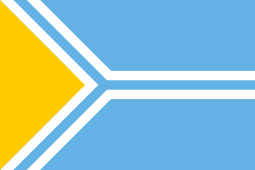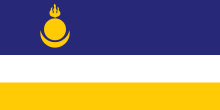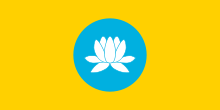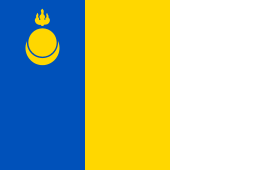Flag of Tuva
 | |
| Proportion | 2:3 |
|---|---|
| Adopted | September 18, 1992 |
| Design | A horizontal blue; with a yellow triangle based on the hoist bordered with a white triangle. Over the partition lines is a blue pall edged in white. |
| Designed by | Oyun-ool Sat, I. C. Salchak and O. I. Lazarev |
The flag of Tuva, a republic in the Russian Federation, is a light blue field with a white-fimbriated pall of the same color bordering a yellow triangle on the hoist.
White symbolizes silver and virtue; additionally, it is common in Tuva for hostesses to greet guests with silver streamers in their arms. The yellow triangle symbolizes gold and Buddhism. Blue symbolizes the morals of nomadic herdsmen (who are commonly respected in the region), as well the Tuvan sky. The blue pall symbolizes the confluence of the Bii-Khem (Bolshoy Yenisei) and Kaa-Khem (Maly Yenisei) rivers at the Tuvan capital of Qızıl, where they form the Yenisei River, known to locals as the Ulug-Khem River.
The flag was created on September 18, 1992 by Oyun-ool Sat, I. C. Salchak and O. I. Lazarev. The proportions are 2:3.
See also
-
 Flag of the Tuvan People's Republic
Flag of the Tuvan People's Republic -
 Flag of Mongolia
Flag of Mongolia -
 Flag of Buryatia
Flag of Buryatia -
 Flag of Kalmykia
Flag of Kalmykia -
 Flag of Agin-Buryat Okrug
Flag of Agin-Buryat Okrug -
 Flag of Ust-Orda Buryat Okrug
Flag of Ust-Orda Buryat Okrug -
 Flag of Vanuatu (adopted 1980), which the flag of Tuva closely resembles.
Flag of Vanuatu (adopted 1980), which the flag of Tuva closely resembles. -
 Flag of South Africa (adopted 1994), which the flag of Tuva also closely resembles.
Flag of South Africa (adopted 1994), which the flag of Tuva also closely resembles.